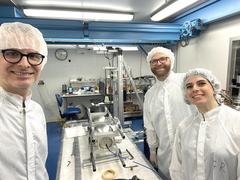URL: https://www.desy.de/news/news_search/index_eng.html
Breadcrumb Navigation
DESY News: Gravity cavity
News
News from the DESY research centre
Gravity cavity
It is quite common for research equipment to end up in display cases and exhibition rooms: discarded prototypes, particularly attractive particle detectors or innovative new developments help to explain science and are technological witnesses to the times. However, it is rather rare for exhibits to be dusted off and moved from the glass cabinet back into the research centre. At DESY, however, one such exhibit has recently begun its second life: a cavity (a cavity resonator that is actually used to accelerate particles) that was previously on display in Genoa is now to help find gravitational waves and axions.

New life for an exhibit: Krisztian Peters, Marc Wenskat (both DESY) and Bianca Giaccone (FNAL) want to measure gravitational waves with the help of cavities. Image: DESY, Krisztian Peters
Researchers from DESY and the Universität Hamburg as well as from the Fermilab research centre in the USA suddenly became interested in the cavity once produced for this purpose by the Italian research organisation INFN in collaboration with CERN. Accelerator physicist Marc Wenskat and experimental physicist Krisztian Peters jointly lead the project. ‘We enquired in Genoa whether we could use the cavity and, independently of us, Fermilab also contacted them at the same time,’ he explains. ‘We then formed a collaboration between DESY, the University of Hamburg and Fermilab, in which not only accelerator development and particle physics, but also theory and astrophysics play important roles.’ As a first step towards a completely new experiment, they first repaired and characterised the exhibition cavity.
To do this, it had to leave its display case in Genoa and travel to the DESY campus in Bahrenfeld - according to Wenskat, the only place in Germany at least where all the tests and corrections could be carried out that the team needed to refurbish the cavity. The great expertise in superconducting high-frequency technology, which is also used for the European XFEL, can likewise be applied to components that look somewhat different from the XFEL accelerator cavities. The material is the same - high-purity niobium, a metal that becomes superconducting at very low temperatures - only the shape is different: the gravitational wave cavity consists of two cells in the shape of a Kinder egg, welded together slightly offset from each other. The detection idea: electromagnetic fields are fed into both cells, which oscillate in phase with each other. If an external influence (such as a gravitational wave) changes the shape of the cavity for a tiny moment, the field inside it also changes. To achieve this, the cavity must be protected as well as possible from external influences that are not gravitational waves. Knowing it precisely inside and out is another prerequisite.
In order to get to know it, the team first repaired its transport damage and then mechanically measured and ‘tuned’ it, i.e. moulded it into a shape that is optimally adjusted to the frequency that is to be maintained in the cavity. ‘You never learn more about a system than when it's not working,’ says Wenskat. With this cavity, the DESY team - currently consisting of the two project leaders, three doctoral students and experts from various groups at DESY - has learnt a great deal about the system in two years.
They learned so much that they were ready for the second step: further measurements and adjustments at very low temperatures. These tests were carried out at Fermilab. The cavity is now back in Hamburg to enable the first scientific measurements to be taken in one to two years' time. ‘You should never say never, but we don't expect to see gravitational waves or axions, to which it is also sensitive, with this system,’ says Peters. ‘Nevertheless, these measurements will be of great importance for the long-term goal.’
The long-term goal is a completely new experiment: a specially constructed new cavity in its own cryostat, a kind of large, ultra-cold refrigerator that can then search for gravitational waves even more efficiently. All measurements and tests on the former exhibition model are steps on the way to ‘SHOGWAVE’ (‘Superconducting cavities for the observation of gravitational waves’). This is the name of the experiment that the team would like to put into operation on the DESY campus in a few years' time.

Step 1: Precise characterisation of the cavity
The long-term goal is a completely new experiment: a specially constructed new cavity in its own cryostat, a kind of large, ultra-cold refrigerator that can then search for gravitational waves even more efficiently. All measurements and tests on the former exhibition model are steps on the way to ‘SHOGWAVE’ (‘Superconducting cavities for the observation of gravitational waves’). This is the name of the experiment that the team would like to put into operation on the DESY campus in a few years' time.
Original publication:
Lars Fischer et al., First characterisation of the MAGO cavity, a superconducting RF detector for kHz–MHz gravitational waves. Classical and Quantum Gravity May 202542(11)



